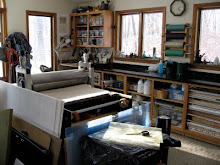Ever since super-storm Sandy hit New England, the coast has been crawling with heavy machines; or as I see them, giant metal prehistoric beasts. Everywhere you look there are machines of every shape and size pushing sand around, moving rock or tearing things down. When they're in demolition mode, its like a feeding frenzy. I've had the opportunity to take a lot of photos, up close and personal in some cases, that would make great reference material for prints. I'm thinking a collagraph would be the perfect process to best capture these down and dirty machines. I'll be able to play up the textural surfaces and experiment with inking options.
Decades ago, when I began to seriously focus on printmaking, I fell in love with the collagraph process. I enjoyed everything about it; building up the plate, experimenting with a variety of adhesives, textures and surfaces, the challenge of inking the plate and the thrill of pulling a print.
With a collagraph, there are often unexpected surprises and things don't always come out the way you expect. They can be tricky to ink and you need to be careful when it comes to setting the pressure; too much and the plate can tear through the paper, too little and you lose the textural detail. There's a certain degree of predictability of course, but often "happy accidents" make for surprising outcomes. I think returning to my "first love" will be a good way to shake things up here in the studio.
I began by working up some sketches and playing around with simplifying some of the detail on the machines. My plan is to focus on the demolition aspect and try and create a sense of a "feeding frenzy". I culled through my photos looking for the best examples of the business end of the machines. I wanted a variety of angles and positions to work with.
The demolished buildings end up being a crunched up mass of tangled shapes. I'm going to try and simplify them as much as I can and pay attention to the texture of the materials I glue down to help create values. Extra details can be incised using an x-acto knife.
The great thing about collagraphs is that they can be inked and wiped as an intaglio plate and then the surface can be rolled as a relief to add additional colors and highlight details. I often use stencils to restrict color placement to targeted areas.
After playing around with a few different compositions, I settled on the image below. I like the idea of a diptych; one plate focused on the "chomping" part of the beast and the other dealing with the results. I'm also toying with the idea of cutting out around the subject matter so I can print a wood grain in the background (I'll raise the grain with a wire brush to make the texture stand out) then print that first as a relief followed by the collagraph. Too early to tell yet and I need to keep my options open. This could be interesting.








